“Hello. My name is Fred Stein, I’m a photographer, left-wing, and I would like to take your picture.”
This is how Fred Stein used to strike up a conversation with people he hoped to portray. Between 1933 and 1967 he managed to make more than 1,200 portraits this way. The words show he had not only the courage to approach people, but also a talent for quickly putting those who had caught his eye at ease.
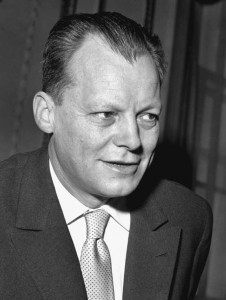
Willy Brandt, New York 1957
© Estate of Fred Stein
Fred Stein took a passionate interest both in those he portrayed and their work. With André Malraux, Arthur Koestler, Egon Erwin Kisch, and countless other peers he discussed the political landscape in Europe of the 1930 and 40s. Willy Brandt and he became firm friends and remained so all their lives long, and likewise others whose portrait he made. In a letter of 10 May 1983, Brandt recalled:
“I met Fred Stein when we were both refugees and fighting the totalitarian Nazi regime with the rather modest means at our disposal. He was a man ahead of his time, an avant-garde and brilliant photographer, inspired by the commitment to justice and concern for truth so clearly reflected in his photographs. → continue reading
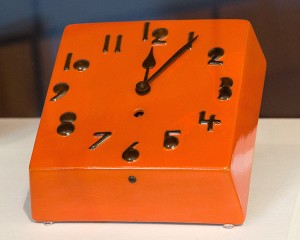
Clock, designed by Greta Heimann-Loebenstein.
Gift from the heirs of Greta Heimann-Loebenstein.
© Jewish Museum Berlin, photo: Nadja Rentzsch
“I chose this clock,” says Leonie* (8 years old) pointing to the showcase. The clock is red and the numbers look a bit strange. She laughs. “A clay clock!” She’s never seen anything like it. The children study the cups, pots, and vases in the big cabinet intently. They gaze, curiously, at the shapes, colors, and designs. They’re supposed to pick the object they like best. Then they’ll learn the name of the ceramicist who made it, its purpose and appearance.
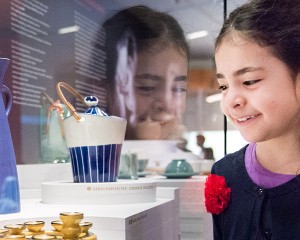
Children’s tour through the cabinet exhibition “Tonalities. Jewish Women Ceramicists from Germany after 1933”
© Jewish Museum Berlin, photo: Nadja Rentzsch
Jona (7) exclaims: “I like this bowl best. Grete made it.” “I think that design is lovely. What would you put in the bowl?” Anna (43) asks him.
Anna is guiding the children from a Berlin elementary school through the cabinet exhibition “Tonalities. Jewish Women Ceramicists from Germany after 1933.” Without hesitating, Jona answers: “Apples or bananas, or even nuts.” “Maybe even pears, or bread!” calls out Elsa (8).
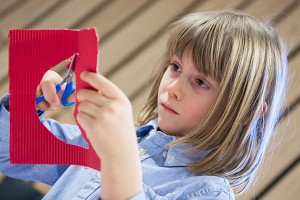
Workshop at the studio in the Academy of the Jewish Museum Berlin
© Jewish Museum Berlin, photo: Nadja Rentzsch
Her favorite object is a candlestick. It’s beige and was made by the ceramicist Hanna. Anna asks the class, “Do you all know what celebration this candlestick would be used for?” Leonie’s hand flies up; she knows the answer: Hanukkah. She has just participated in a candle-dipping workshop for the Jewish Festival of Lights in December.
After the tour, the children start working on their own projects. → continue reading
Fred Stein was only twenty-four years old when he had to flee Germany in 1933. A rabbi’s son and member of the Socialist Workers’ Party, he had studied law and hoped to work as an attorney, defending people’s rights. When he learned by chance that the Gestapo was planning to arrest him, he and his wife Lilo fled to Paris under the pretext of taking a honeymoon trip. In exile, the young couple was obliged to rethink its future.
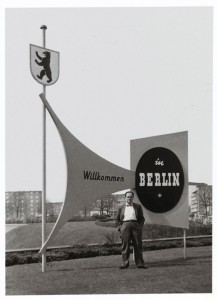
Fred Stein, Berlin 1958
© Estate of Fred Stein
A Leica camera, the wedding present they had bought for themselves, proved to be the key to a new career. Fred Stein began taking photographs: street scenes in downtown Paris and portraits of celebrities, many of whom were German emigrants. In 1941 Fred and Lilo Stein, who by then had a little daughter, managed to flee a second time. They reached New York on one of the last ships out. There, Fred Stein once again devoted himself to shooting portraits and street scenes.
In 1958 Fred Stein returned to Germany for the first time in twenty-five years. He was prompted to do so by Will Grohmann’s planned publication of the book Deutsche Porträts [German Portraits]. Fred Stein was commissioned to photograph Konrad Adenauer, Heinrich Lübke, Ludwig Erhard, and other politicians, as well as artists, authors, and publishers, such as the young Axel Springer, or Rudolf Augstein. Yet apparently, many a German head he portrayed for the book posed a dilemma for him. → continue reading




